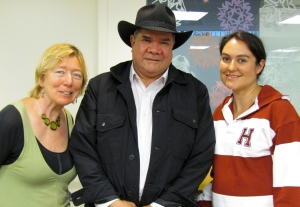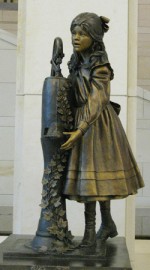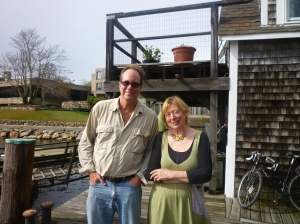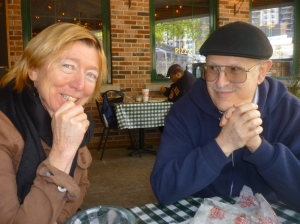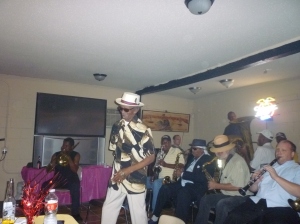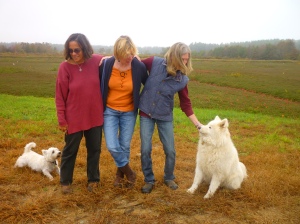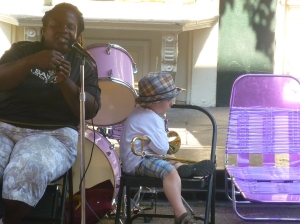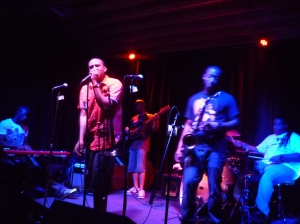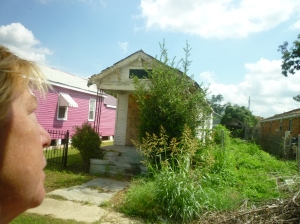You are currently browsing the monthly archive for December 2011.
From the elegant brownstones of Brooklyn to the chilly pavements of Montreal, my study tour of North America was an illuminating insight into how oral history and radio connect us through the sharing of personal stories. At the Brooklyn Historical Society, on the twentieth anniversary of the Crown Street riots between Hasidic Jews and West Indian and African-American communities, curator Sady Sullivan was developing the Crossing Borders, Bridging Generations project, which explores ‘mixed-heritage families, race, ethnicity, culture, and identity’. Although the demographics and history of Brooklyn are very different from here, she found resonances with my research into mixed marriage and sectarianism between Catholics and Protestants in Australia, published as an ABC radio documentary, Marrying Out. It was a thrill to learn that my experiences of interviewing were part of a training course in cross-cultural research at BHS.
At Harvard, while students lounged about the famous square and a boisterous group sang Happy (375th) Birthday to its founder, more synergies became apparent. At a seminar hosted by the Harvard University Native American Program and chaired by Professor Mick Dodson, the visiting co-Chair of Australian Studies, I played the voices of Indigenous Australians I had recorded in the West Kimberley. Native Americans listened sympathetically as they described being taken from their mothers as toddlers to be reared by Catholic nuns, losing not only their family but their language and culture. The suffering of the Stolen Generations is well documented in the Bringing Them Home Report (1997) co-authored by Mick Dodson. But even he was shocked by the conditions endured by Native Americans. In the Smithsonian Museum in Washington D.C., we read about the Chiricahua Apache nation, several hundred of whom – men, women and children – were removed from their lands by the US military in 1886. Some remained official ‘prisoners of war’ for 28 years.
In Washington, I visited the sombre Vietnam War memorial wall, and the memorial to the military nurses, discussed in my book Minefields and Miniskirts, an oral history of Australian women’s roles in the Vietnam war. That book was reviewed in the US by Donald A Ritchie, a prominent oral historian. Don’s day job is as US Senate Historian. So it was an extraordinary privilege to be escorted round the Capitol by Don, who has worked there since 1976, and recently edited the transcripts of the infamous Senator Joe McCarthy trials. Amidst the splendid statues of former US presidents, he pointed out a bronze sculpture of Helen Keller, unveiled in 2009 by then Governor of Alabama, Bob Riley. Don wondered if the very conservative Riley knew, as he praised the deaf and blind woman’s resourcefulness, that Keller had gone on to become a radical activist who championed the causes of women’s suffrage and workers’ rights.
The crafting of oral history for radio documentary so as to harness the affective power of voice, was a major theme of presentations I gave at places as diverse as Boston University, Concordia University’s Centre for Oral History and Digital Storytelling in Montreal, and the impressive Centre for Documentary Studies at Duke University, set in a classic Southern Mansion complete with white rocking chairs on the porch. My favourite was my talk to rookie radio makers at Woods Hole on Cape Cod, the small and charming town that is the unlikely site of the oceanographic institute that discovered the wreck of the Titanic. It is also home to Transom, a visionary public radio showcase established by the indefatigable Jay Allison, who invited me (and luminaries like This American Life’s Ira Glass) to share their passion for the medium. Jay is a True Believer in the importance of radio to serve and connect the community; over four decades, he has pioneered numerous broadcasting initiatives, from the airing of early documentaries on child sexual abuse to his current public storytelling event, The Moth, lauded in the Wall Street Journal. It was a delight to engage with such a kindred spirit – my interview with Jay and others will feature in a forthcoming book (2013).
The trip ended, fittingly, in Chicago, with a homage to Studs Terkel, whose 9,000 oral history interviews are being digitised at the Smithsonian. There I met Studs’s son Dan, at the home where Studs crafted his mesmerising tomes of American life, which revealed the ‘precious metal’ he sought to divine in everyone he met. A burglar broke into this very living-room late one night, Dan told me, and was surprised to find the sofa occupied by Studs’s ailing wife, Ida. Studs was sleeping in a chair alongside, to watch over her. He readily handed over his wallet and the burglar made to go. Then Studs politely asked the intruder if he could lend him $20 from the wallet, to buy Ida’s medicine next day. Taken aback, the burglar handed over the money. As he headed for the window, Studs intervened and cordially escorted him out the front door.
Studs’s interviews were driven by sheer fascination with the human condition. His gravestone, he once remarked, should be inscribed ‘curiosity never killed THIS cat’. In the end, Studs dispensed with any gravestone, preferring to have his ashes co-mingled with those of his beloved Ida and buried at the Chicago equivalent of Speakers’ Corner, known as Bughouse Square. After Studs’s death in 2008 at the age of 96, Dan placed his parents’ ashes in an unmarked spot in the park. It seemed an entirely appropriate place to end a trip that celebrated the politics of connection and the democratising power of voice.
13 states, five weeks, thousands of kilometres, from the swelter of a Louisiana bayou to the glorious fall foliage of Vermont…
Interviews with wonderful radio-makers and visionaries, and with oral history venerables… will write about that soon.
Favourite place N’Awlins, just because of those folks’ big heart and unstoppable music. We stayed in Treme, oldest African-American neighbourhood in the US, and badly hit by Katrina. Sad to see boarded up houses and even worse, vacant blocks, where everything had been wiped out. But the Treme Brass Band still plays wild music every Wednesday night in the old neighbourhood hall – $5 gets you rice and beans and the best live jazz music you’ll ever hear. I’m a hopeless fan of the TV series of course – so it was cool to see the oh-so-elegant elder of the band, in his crisply pressed trousers and white hat, presiding over an increasingly exuberant occasion. I ended up on the dance floor, along with everyone else, including the bartender – a woman who insisted we could not be allowed to walk the two blocks home. Instead, she lined up a ride home for us – with the leader of the Treme Brass Band, Mr Benny Jones. An absolute highlight – thank you ma’am!
Washington was a surprise; hadn’t realised how impressive that monument mile is. Wonderful tour of the Capitol with insider Don Ritchie, Senate Historian there since 1976. I met Don back in the ’90s when he chaired a session I did at the Oral History Association of Australia in Alice Springs in central Australia. The red dust of Alice a bit of a change from D.C.!
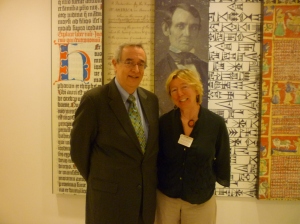
Donald Ritchie, US Senate Historian, gave me a splendid tour of the awesome Capitol in Washington D.C
Also a memorable hike on the Cranberry Bogs of Massachusetts with Studs Terkel’s old friend and collaborator, the funny, astute and delightful Sydney Lewis and her hospitable friend Sarah, ace broiler of swordfish.
In real life, I talk a lot. Like way too much! Sometimes I even bore MYSELF, going on and on in broken record mode about some ancient grievance or tedious domestic whinge. But when I get out my audio recorder to capture someone else’s story, I morph into a model of mute and rapt attention. Someone called it aerobic listening, which describes well the intensity with which I absorb what the person Read the rest of this entry »
On our first morning in the French Quarter, we happened on this curious quartet: a soulful African-American woman singing and playing clarinet, what looked like her daughter, aged about eight, on a pink drum set, a fabulous guy on rhythm tuba behind, and this odd little white kid hanging around with a trumpet. He didn’t play while we were there, but once did a sort of shuffle towards the spectators. She sang and then went into what seemed like effortlessly soaring clarinet – listen to it here. And that was just Day One!
Later, at DBA, a club on Frenchman’s with free or very cheap entry, we heard Glenn David Andrews. Glenn had a colourful past, we were told, had been in prison and stuff, but was getting back in touch with the community and had appeared in Treme, the HBO series we loved, along with his cousin, the fabulous Trombone Shorty. Wearing a t-shirt and boardshorts, Glenn didn’t look as cool as his backing musicians – but once he started playing that trombone, we were gone. He came down on the floor to sing Happy Birthday to a friend, brandishing and working the instrument and sounding like a young bull elephant about to charge. And funny too – ‘ I want y’all to dance – even you white folks’. For energy, soul and pzazz, he was the best live act we’d ever seen – until the next night, when the Treme Brass Band played the CandleLit Lounge.
Beneath all the partying was the ever-present pall of Katrina. Vacant blocks among the colourful housing in the Treme area looked innocuous, but each one had once been a home. Other houses were boarded up, or showed obvious damage. What enrages residents even now is that
a) it could have been avoided: the hurricane was a natural disaster, but the impact was manmade – the levees were not built deep enough and using properly constituted soil, so they could withstand the floods
b) emergency relief was slow and inadequate, because New Orleans folk were largely black and poor. Can’t imagine the same pathetic response happening in Boston or New York, eh.
We stayed with a lovely couple in Treme, Michael, a native New Orleanser, and David, a ‘convert’ from New England. They were lucky – they ‘only’ had about four foot of water in their home, a converted corner pub. David cried when I asked him about the casualties. The numbers didn’t even depict the reality, he said. So many folk died later, due to fractured families and broken hearts. The effects were felt in little ways for so long – like the fact that two years after Katrina, inner city residents like David still did not get mail delivered to their home. I found that astonishing in a country as rich as the US – but here’s David, telling it like it was.

